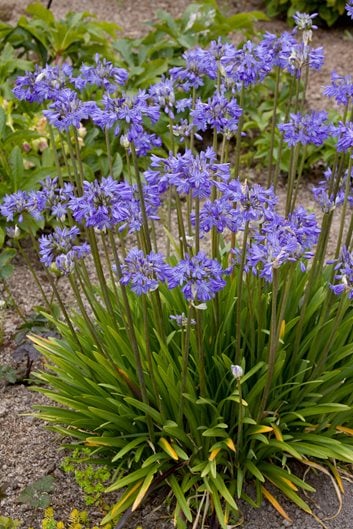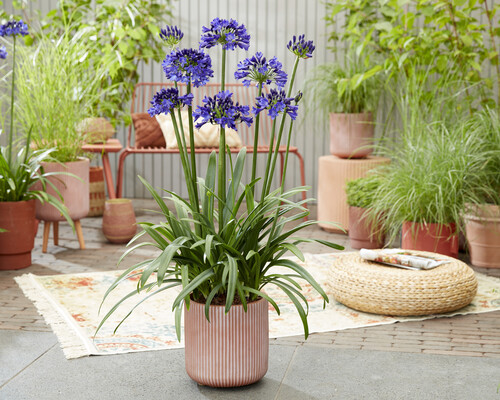Usual Agapanthus Issues and Exactly How to Resolve Them
Letting Loose the Secret to Effective Agapanthus Farming: Tips and Tricks for a Flourishing Garden
In the world of gardening, growing agapanthus successfully needs a critical technique that incorporates different elements of plant care. By recognizing the subtleties of agapanthus cultivation, one can develop an environment where these plants flourish and grow perfectly.
Growing Agapanthus: Best Practices
When planting Agapanthus, proper dirt prep work is necessary for making sure effective development and development of these beautiful flowers. Agapanthus, commonly understood as Lily of the Nile or African lily, flourishes in well-draining soil with a slightly acidic to neutral pH degree - Agapanthus. Before growing, it is important to modify heavy clay dirts with raw material such as garden compost or peat moss to enhance drain and supply essential nutrients for the plants
To grow Agapanthus, select a place that receives full sunlight to partial shade, as this will advertise healthy growth and plentiful flowering. Dig an opening twice the size of the plant's origin ball and position the Agapanthus at the exact same depth it was previously growing. Carefully backfill the hole with soil, pushing down strongly to remove any type of air pockets around the origins.
Water the newly grown Agapanthus thoroughly and continue to maintain the soil evenly damp, specifically throughout the plant's energetic growing season. Agapanthus. Applying a well balanced plant food once a month can additionally support the plant's growth and blooming. By adhering to these finest practices for growing Agapanthus, you can create a stunning display screen of these captivating blossoms in your yard
Perfect Dirt Conditions for Agapanthus
For optimal growth and growing success of Agapanthus plants, making certain the dirt problems are excellent is critical. Agapanthus likes soil that is rich in nutrients, so including a well balanced plant food during the expanding period can promote healthy and balanced growth and vivid blossoms.

Watering and Fertilizing Tips
To guarantee healthy development and vibrant blossoms, appropriate watering and feeding methods are vital for successful Agapanthus cultivation. Agapanthus plants gain from routine watering, specifically throughout the expanding season. It is recommended to water deeply once a week, guaranteeing the dirt is wet but not waterlogged. Throughout heat or in pots, more frequent watering may be required to stop the soil from drying out completely.
When it comes to feeding Agapanthus, a well balanced plant food with equivalent parts nitrogen, phosphorus, and potassium can be applied in the springtime to advertise healthy development and blooming. Slow-release fertilizers are excellent for supplying nutrients gradually over an extended duration. Prevent over-fertilizing, as this can result in excessive vegetation development at the cost of flowers.
Additionally, including organic issue like garden compost into the soil can boost nutrient levels and improve dirt structure, assisting in the overall health and wellness of the Agapanthus plants. By adhering to these watering and fertilizing ideas, gardeners can guarantee their Agapanthus plants grow and create spectacular displays of blossoms.
Pruning and Deadheading Strategies
Appropriate trimming and deadheading methods play an important function in keeping the health and wellness and aesthetics of Agapanthus plants, matching the important techniques of watering and fertilizing for effective farming. Pruning Agapanthus includes getting rid of invested blossom heads, yellowing or dead leaves, and overall shaping of the plant to advertise better growth. Deadheading, the procedure of removing discolored blossoms, not only improves the plant's look but likewise urges further flowering.
When deadheading Agapanthus, it is recommended to trim off the blossom stem at the base using sharp, tidy shears. This procedure redirects the plant's energy from seed manufacturing back into origin and vegetation growth, promoting a much healthier and more robust plant. Regular deadheading can prolong the blooming period of Agapanthus and avoid self-seeding, which can cause congestion.
In regards to trimming, Agapanthus usually gain from a light trim after blooming to clean the plant and urge fresh development. Reducing back the invested blossom stems and removing any kind of broken or dead foliage aids keep the plant's vitality and overall appearance. Nevertheless, it is necessary to stay clear of reducing right into the crown of the plant, as this can damage its wellness.

Protecting Agapanthus From Vermins and Diseases
Applying effective bug and condition administration techniques is essential to safeguarding the wellness and vigor of Agapanthus plants in growing. Agapanthus are typically sturdy plants, however they can still succumb different pests and conditions otherwise appropriately taken care of. One common parasite that impacts Agapanthus is the you could check here Agapanthus borer, a caterpillar that passages right into the plant, causing damages to the leaves and blossoms. To avoid problems, routine inspection of the plants is essential. If borers are identified, they can be manually eliminated, or insecticidal soap can be made use of as a control step.
In addition to pests, Agapanthus are at risk to conditions such as origin rot and fungal leaf spots. By remaining vigilant and addressing pest and condition problems without delay, garden enthusiasts can assist their Agapanthus prosper and grow.

Final Thought
To conclude, successful cultivation of agapanthus needs proper planting methods, perfect dirt conditions, appropriate watering and fertilizing, normal pruning and deadheading, and security from conditions and insects. By adhering to these methods and tips, gardeners can make certain a flourishing yard full of gorgeous agapanthus blooms. Agapanthus. Remember to preserve regular care and interest to information to advertise the health and durability of these sensational plants
When planting Agapanthus, appropriate dirt prep work is necessary for ensuring effective growth and growth of these lovely flowers.Water the recently grown Agapanthus completely and proceed to maintain the soil evenly moist, particularly throughout the plant's active expanding period.For ideal development and flowering success of Agapanthus plants, making certain the dirt conditions are ideal is essential. When planting or hair transplanting Agapanthus, ensure the dirt is well-prepared to give the required structure for the plants to develop Going Here themselves efficiently. site One usual parasite that affects Agapanthus is the Agapanthus borer, a caterpillar that passages into the plant, triggering damages to the flowers and fallen leaves.